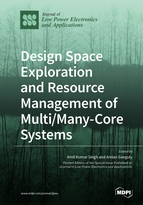Design Space Exploration and Resource Management of Multi/Many-Core Systems
A special issue of Journal of Low Power Electronics and Applications (ISSN 2079-9268).
Deadline for manuscript submissions: closed (30 September 2020) | Viewed by 28815
Special Issue Editors
Interests: embedded systems; MPSoC; NoC; design space exploration; run-time mapping
Special Issues, Collections and Topics in MDPI journals
Interests: interconnection network; Network-on-Chip (NoC); multi-chip system integration; wireless interconnects; data center networks
Special Issues, Collections and Topics in MDPI journals
Special Issue Information
Dear Colleagues,
The reliance of computing systems of various scales, e.g., emebbeded to cloud computing, is increasing on multi/many-core chips mainly to satisfy the high performance requirement of complex software applications. These systems are typically referred to as multi/many-core systems. At the same time, depending upon the application domain, these systems also demand energy efficiency, reliabilty and/or security. These demands can be fulfilled by exploring the design space by considering the software applications and the multi/many-core chips to find the design points leading to efficiency in all the required metrics depending upon the application domain.
Further, considering varying workloads in the systems over time, efficient resource management methodologies need to be developed to meet the requirements of performance, energy efficiency, reliability and/or security. These methodologies can perform resource management decisions online without any prior analysis or can exploit offline explore design space to take efficient run-time decisions and, thus, management.
Authors are invited to submit regular papers following the JLPEA submission guidelines, within the remit of this Special Issue call. Topics include but are not limited to:
- Design space exploration (DSE) techniques for multi/many-core systems;
- DSE considering optimisation for one or more metrics, such as accuracy, performance, energy consumption, reliability and security;
- Resource management considering various principles, e.g., machine learning and heuristics;
- Adaptive and hieracrchical resource management;
- Approximate computing to achieve trade-offs for various metrics.
Dr. Amit Kumar Singh
Dr. Amlan Ganguly
Guest Editors
Manuscript Submission Information
Manuscripts should be submitted online at www.mdpi.com by registering and logging in to this website. Once you are registered, click here to go to the submission form. Manuscripts can be submitted until the deadline. All submissions that pass pre-check are peer-reviewed. Accepted papers will be published continuously in the journal (as soon as accepted) and will be listed together on the special issue website. Research articles, review articles as well as short communications are invited. For planned papers, a title and short abstract (about 100 words) can be sent to the Editorial Office for announcement on this website.
Submitted manuscripts should not have been published previously, nor be under consideration for publication elsewhere (except conference proceedings papers). All manuscripts are thoroughly refereed through a single-blind peer-review process. A guide for authors and other relevant information for submission of manuscripts is available on the Instructions for Authors page. Journal of Low Power Electronics and Applications is an international peer-reviewed open access quarterly journal published by MDPI.
Please visit the Instructions for Authors page before submitting a manuscript. The Article Processing Charge (APC) for publication in this open access journal is 1800 CHF (Swiss Francs). Submitted papers should be well formatted and use good English. Authors may use MDPI's English editing service prior to publication or during author revisions.
Keywords
- Multicore and many-core
- Design space exploration
- Resource management
- Security
- Reliability
- Energy efficiency
- Machine learning
- Approximate computing







